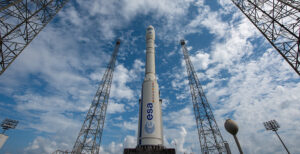Vega’s is slated to launch April 20 from the Guiana Space Centre in French Guiana carrying the 750-kilogram Pléiades-Neo 1, a high-resolution Earth observation satellite built and operated by Airbus Defence and Space.
In addition to its primary payload, the mission will also carry a number of secondary payloads including Eutesat’s ELO Alpha cubesat, and three Lemur-2 satellites for Spire Global, the San Francisco-based data analytics provider that announced March 1 plans to go public by merging with a special-purpose acquisition company, or SPAC.
Vega’s upcoming return to flight follows a string of two failures in its last three launch attempts. The first, in July 2019, resulted in the destruction of the United Arab Emirates’ FalconEye1 Earth observation satellite.
The most recent failure occurred Nov. 16 when Vega’s upper stage malfunctioned eight minutes after liftoff from Europe’s French Guiana spaceport. The failure resulted in the loss of both of the rocket’s payloads, the Spanish SEOSAT-Ingenio Earth observation satellite and the 175-kilogram TARANIS satellite built by the French Space Agency CNES.
Following an investigation, it was concluded that two misconnected cables on the rocket’s Avum upper stage were to blame for the failure. The joint Avio and Arianespace investigation concluded that the Italian rocket maker would need to reexamine two vehicles that had already been prepared for launch, and update and improve procedures for vehicle integration and testing.
Vega’s April return to flight will be used to verify the vehicle’s reliability, both to launch partners Arianespace and its customers, as well as to catch up on a backlogged flight manifest, Delorenzo told SpaceNews.



